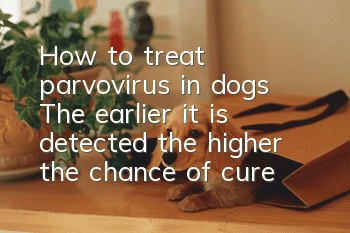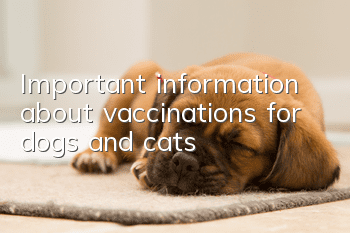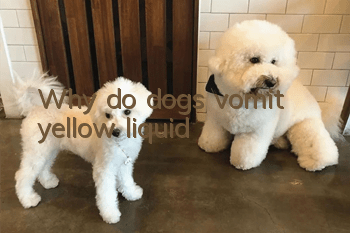How to treat parvovirus in dogs? The earlier it is detected, the higher the chance of cure!

What is a small dog?
Canine parvovirus is highly contagious to dogs, and dogs of all ages can be infected. However, dogs that have just been weaned to 90 days old are more likely to suffer from the disease and their condition is more serious. Some puppies suddenly have difficulty breathing and die suddenly within a short period of time. According to the types of clinically affected dogs, purebred dogs and exotic dogs have a higher incidence rate than native breed dogs. This disease can occur throughout the year, but is more common in winter and spring when the weather is cold. The feces of sick dogs contain the highest levels of poison.
Through consultation, determine whether the sick dog has been in contact with a sick dog suffering from parvovirus disease. A preliminary diagnosis is made based on clinical symptoms, such as frequent vomiting, severe diarrhea, and fishy-smelling dark red or tomato juice-like bloody stools. Confirmation requires specific diagnosis.
Diagnosis of dog feces
1 CPV rapid diagnosis test plate Take a small amount of dog feces, dilute it with a diluent mixture, use a pipette to absorb 1 to 2 drops of the diluent, and add it to the test Plate small holes, and determine the result after 10 minutes. If there is only one C line on the test paper, there are two lines, namely C line and T line, both of which are negative results. This method has a high detection rate and is of great help to basic clinical workers.
2 Hemagglutination and hemagglutination inhibition test This method is simple, economical and applicable, but has low sensitivity. Domestic hemagglutination and hemagglutination inhibition tests are mainly used to monitor CPV levels and have not yet been applied clinically.3 Electron Microscope Observation Units with conditions can directly use the supernatant of feces for negative electron microscopy examination. The feces is first treated with chloroform. Then, after centrifugation at 5000 r/min for 10 min, the supernatant was taken, stained with phosphotungstic acid, and observed under an electron microscope. At the beginning of the disease, scattered virus particles of uniform size can be seen; in the later stage of infection, due to the presence of intestinal mucosal secretory antibodies in the intestine, the virus appears in a state of aggregation.
Clinical symptoms of parvovirus infection in dogs
Dogs infected with parvovirus can be clinically divided intoenteritis type and myocarditis type.Enteritis type: natural infection incubation period is 7-14 days. The initial manifestations of the disease are fever, the body temperature can reach above 40 degrees Celsius, depression, lack of food, and vomiting. The initial vomitus is food, which is mucus and yellow-green fluid. The diarrhea started one day after the onset of the illness. At the beginning of the disease, the stool is like porridge. As the disease progresses, the stool smells like ketchup or coffee, has a strong odor, and the frequency of bowel movements is uncertain. After bloody stool, the sick dog's eyeballs were sunken, its nose was dry, its body was weak, and its weight dropped significantly. At the same time, the conjunctiva is pale, and symptoms of severe anemia can be seen. If left untreated, it can cause poisoning of intestinal contents, shock and coma. Death is a mystery.
: The total number of red blood cells, hemoglobin decreased, the specific volume decreased, and the white blood cells decreased. The number of white blood cells in sick dogs can be as low as 60-90% (reduced from 1.2thousand/cubic millimeter in normal dogs to less than 4,000). The initial vomitus is food, which is mucus-like, yellow-green or contains blood. It takes about a day after the onset of symptomsDiarrhea begins. The feces will be loose at the beginning of the disease. As the disease progresses, the feces will become brown or tomato paste-colored and bloody. Later, the frequency increased, tenesmus became severe, and bloody stools had a special fishy odor. A few hours after the bloody stool, the sick dog showed symptoms of severe dehydration, sunken eyeballs, dry nose, reduced skin elasticity, and significant weight loss. Due to the corruption of intestinal contents, it can cause internal shock, shock, coma and death. Timely and reasonable treatment can reduce mortality.
Myocarditis is more common in dogs around 40 days old, and the precursor symptoms of sick dogs are not obvious. Some dogs develop sudden breathing difficulties, heart failure, and death within a short period of time. Some dogs die from mild diarrhea.
Treatment methods for small dogs
Use antibodies, antibacterial and antiviral, anti-inflammatory, hemorrhage and anti-vomiting; cleanse the gastrointestinal tract, regulate gastrointestinal function, and treat symptoms.(1) Early application of antibodies: immune globulin, double-linked king, Qiangqiangkan, double-linked hyperimmune serum and other specific therapies for treatment. The earlier the clinical application, the better the treatment effect.
(2) Symptomatic treatment: rehydration, hemostasis, antiemesis, antibacterial and anti-inflammatory, and prevention of secondary infection. Available: Bijia Antibacterial, Enli, Yandu 120, Tianxiang Fuke, ofloxacin, ceftriaxone sodium, Maoquanling, Kangyanzhilianyin, etc. for symptomatic treatment. Sick dogs often die due to diarrhea and dehydration, so rehydration is the main measure to treat this disease. During infusion, the infusion volume and infusion speed should be strictly controlled, and attention should be paid to the functional status of the heart, otherwise it may easily lead to treatment failure. When the sick dog shows severe vomiting and diarrhea, dehydration, electrolyte imbalance and acid-base balance need to be corrected. Give oral rehydration salts. (4) Blood transfusion therapy has a good therapeutic effect on this disease; albumin and amino acids can be transfused, combined with traditional Chinese medicine conditioning. Available: Canine Parvovirus Prevention and Treatment No. 1; Canine Parvovirus Prevention and Treatment No. 2; Canine Parvovirus Prevention and Treatment No. 3.
- What are the fierce dogs?
- What injections do dogs need?
- How long does it take for dog swelling to subside after neutering? What management should be paid attention to after surgery?
- How to get a dog registration certificate in Weihai? Get a legal ID card for your dog.
- What does a dog’s sleeping position mean? Go and observe your dog!
- Can dogs eat sour food? I’ll tell you all the ups and downs!
- If your dog shivers in the morning in winter, it’s probably because he’s cold!
- Dog intestines should not be underestimated
- If the dog is not breathing or has a heartbeat, is it dead?
- How many babies can a bear bear in her first baby?



